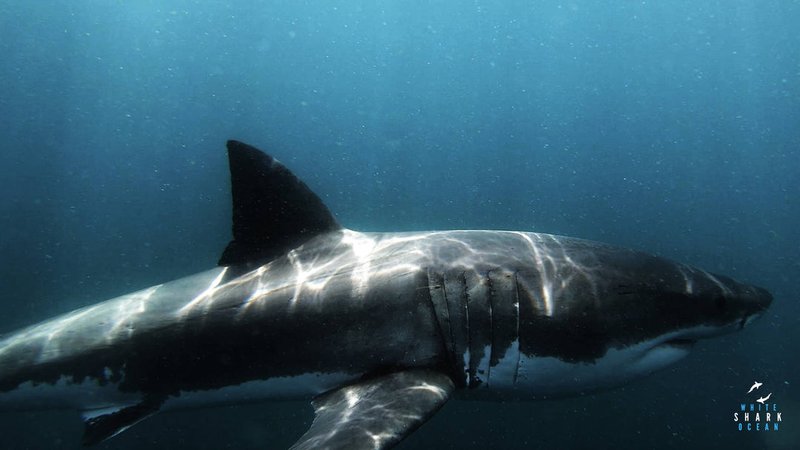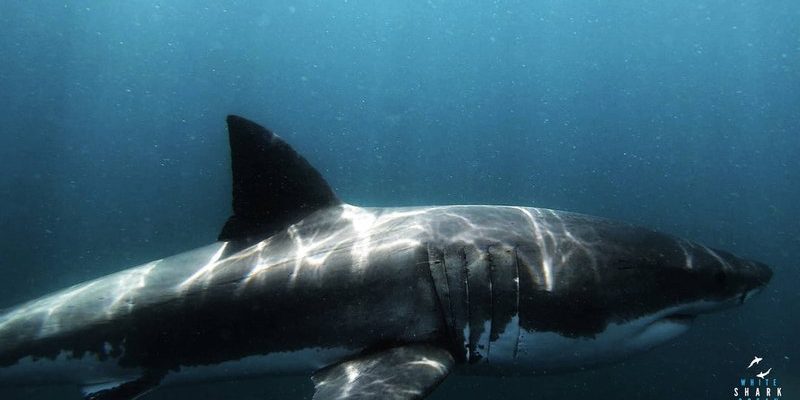
Think about it this way: if you were trying to survive in a crowded city, you’d need specific skills to get around, find food, and avoid danger. Great white sharks do just that, but they do it in an underwater city filled with currents, prey, and other predators. Let’s dive into the various adaptations that help these sharks thrive in their deep-sea habitat.
1. Streamlined Body Shape
One of the standout features of great white sharks is their streamlined body. They are not bulky or cumbersome; instead, their shapes reduce drag and make swimming effortless. This sleek design allows them to reach impressive speeds of up to 25 miles per hour when they need to.
Think of their body like a well-designed sports car—built for speed and agility. This streamlined shape helps them catch fast-moving prey like seals and fish. Without this adaptation, a great white would struggle to keep up with its dinner. The torpedo-like form not only aids in hunting but also helps them conserve energy while swimming long distances.
Another aspect of their body shape is the placement of their fins. The dorsal and pectoral fins are perfectly designed for stability and maneuverability. This means they can cut through the water with grace and precision, turning sharply to chase down prey or evade threats.
2. Powerful Jaws and Teeth
You might be surprised to learn that a great white shark’s mouth is one of its most impressive tools. These sharks possess a set of powerful jaws filled with sharp, serrated teeth that can slice through flesh with ease. When they bite into their prey, it’s like a well-oiled machine—efficient and effective.
Imagine having a toolbox filled with the right tools for any job. Great white sharks have evolved to have around 300 teeth, arranged in several rows. As they lose teeth, replacements move forward, ensuring they always have a fresh set ready for action. This is crucial for their survival since their diet consists mainly of large marine mammals like seals and sea lions.
Beyond just biting, their teeth help them hold onto slippery prey. A seal caught between those powerful jaws won’t escape easily! Plus, these sharks can bite down with a force equivalent to over two tons, which is enough to crush bone. That’s some serious bite power!
3. Acute Senses
Great white sharks are not just powerful; they are also highly intelligent hunters with exceptional senses. They have remarkable olfactory bulbs that allow them to detect blood in the water from miles away. Imagine being able to smell a burger cooking on the grill from three houses down—that’s what they can do with their prey.
In addition to their sense of smell, they have excellent hearing, picking up low-frequency sounds that signify movement in the water. This is useful when hunting, as many animals create vibrations as they swim or struggle. And let’s not forget their keen eyesight! Great whites can see well in low-light conditions, which is perfect for hunting at dawn or dusk when many marine animals are most active.
Perhaps most fascinating is their electroreception ability. Great whites have special organs called ampullae of Lorenzini that detect the electric fields generated by all living creatures. This means they can locate prey even when it’s hidden under sand or camouflaged in the water. It’s like having a built-in GPS that guides them to their next meal!
4. Insulating Layer of Fat
To survive in chilly ocean waters, great white sharks have developed a layer of blubber. This thick layer of fat acts as insulation, keeping them warm and helping them maintain their body temperature. You might think of it as wearing a wetsuit; it allows them to thrive in diverse environments, from warm coastal waters to the frigid depths of the ocean.
This fat not only provides insulation but also serves as an energy reserve. During times when food is scarce, sharks can draw upon this fat layer to sustain themselves—kind of like having a savings account for lean times. Being energy-efficient is crucial for these apex predators, and this adaptation gives them a significant edge.
Interestingly, their buoyancy is also aided by this layer. It helps them stay suspended in water without expending much energy. Instead of constantly swimming to maintain their position, they can glide, allowing them to conserve strength for when they really need it.
5. Ability to Regulate Body Temperature
Unlike most fish, great white sharks can regulate their body temperature. This ability to maintain a warmer internal temperature compared to the surrounding water gives them several advantages. For starters, it allows them to swim faster and be more agile than other fish.
This phenomenon is known as regional endothermy. By keeping their muscles and organs warm, great whites can be active in colder waters where other predators might slow down. This ability gives them access to a wider range of hunting grounds, making them even more formidable hunters.
The great white’s unique circulatory system contributes to this adaptation. They can direct warm blood to key areas, like their muscles, while keeping their core cool. This means they can operate efficiently even in chilly waters—which is especially helpful when hunting seals that often prefer colder habitats.
6. Social Behaviors and Learning
While great white sharks are often thought of as solitary hunters, they do engage in social behaviors that can enhance their hunting success. They have been observed swimming in groups during certain times, especially around areas where food is abundant. It’s like teaming up with friends to tackle a challenge together—sometimes, two (or several) heads are better than one!
Learning plays a crucial role in their survival. Great whites can adapt their hunting techniques based on experiences and observations. For instance, if one shark discovers a successful method for catching seals, others may mimic that behavior. This type of social learning is key in their hunting strategy and helps them become even more effective predators.
These behaviors also highlight their intelligence. Great whites have shown a remarkable ability to adapt to new situations, showcasing problem-solving skills that were once thought to be unique to mammals. They might not be dolphins, but they do have a clever side that helps them thrive in a complex underwater world.
7. Reproductive Adaptations
Great white sharks have a unique reproductive strategy that ensures the survival of their young. They are ovoviviparous, which means the eggs develop inside the female’s body and hatch as live young. This adaptation allows the pups to receive nutrients directly from the mother, increasing their chances of survival right from the start.
One interesting fact is that female great whites can give birth to up to 14 pups at once, but not all make it to adulthood. The mother’s ability to invest in her young through the pregnancy stage is crucial because it gives them a better chance to survive in the challenging ocean environment.
After birth, the pups are on their own, but they are already miniature versions of their parents, equipped with the same adaptations that help keep adults alive. Instincts kick in, and these little predators must quickly learn how to hunt and navigate their environment.
In summary, the great white shark is a fantastic example of how evolution shapes a species to thrive in its environment. From their powerful bodies and keen senses to their social behaviors and reproductive strategies, every adaptation contributes to their success as apex predators.
In the grand tapestry of the ocean, these sharks are a testament to nature’s ingenuity. Understanding the adaptations that help great white sharks thrive not only deepens our appreciation for them but also underscores the importance of protecting their habitats for future generations. So the next time you hear a splashing wave or a seagull’s cry, remember the incredible adaptations of the great white shark hiding beneath the surface, silently navigating the depths of the ocean.

